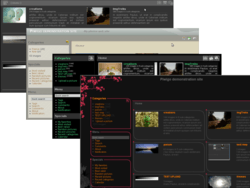Piwigo
|
Piwigo screens | |
| Developer(s) | Pierrick Le Gall and the Piwigo Team |
|---|---|
| Stable release | 2.8.3 (November 22, 2016) [±] |
| Written in | PHP |
| Available in | Multilingual 58 languages |
| Type | Online Gallery |
| License | GPL |
| Website |
www |
Piwigo is photo gallery software for the web, built by an active community of users and developers. Freely available extensions make Piwigo easily customizable. It is notable as a system with many features.[1]
Piwigo is a web-based system that is free and open-source, unlike Flickr or Picasa.[2] This approach is reinforced repeatedly.[3] It is licensed under the GPL. It is written in PHP and requires a MySQL database. It can be installed on your own server.[4]
Main Features
Piwigo is designed to be fast, free, and flexible. It's frequently updated by a passionate community of developers and users who swear by it.[5]
- Add Photos
- Photos can be added via a web form, with FTP client software, with digiKam,[6] Picasa, Shotwell, Lightroom,[7] iPhoto (Mac users), Aperture (Mac users) or mobile applications for iPhone/iPad, Android and Windows Phone
- Multiple size
- each photo is available in 9 sizes, from XXS to XXL, for improved compatibility with various screen resolutions (from smartphones to HDTVs)
- Watermark
- Piwigo can automatically add a watermark on all photos, to protect photos against unwanted copy.
- Albums
- Each image is bound to one or more albums. Albums are hierarchical and there is no limit in depth.
- Tags
- An administrator describes photos with tags, then visitors can browse photos by tags or multiple related tags, for example "night + Paris + John".
- Calendar
- Extracted from Exif metadata, Piwigo knows the date of each photo and is able to display photos for a given day, month or year.
- Themes
- The appearance of the photo gallery is defined by the theme. There are various themes provided by the project community.
- Plugins
- Plugins expand capabilities of Piwigo. Example of plugins: YouTube, Vimeo, Dailymotion, Google Maps or displaying photos in a Lightbox.
- Access control
- Access control is handled by the user manager, restricting and granting varying levels of access to photos and albums.
- Notification system
- Users can be alerted of changes and updates through RSS feeds, E-mail or sharing on social networks Twitter, Facebook or Google+.
- Videos
- With the use of freely available extensions, Piwigo may also be used to handle videos.[8]
Other features are listed on the features page of the Piwigo website.
Deployment
Piwigo can be deployed using various methods in a hosting environment. Users download the current version of Piwigo from Piwigo.org. Either they download the full archive and upload the source code to their hosting environment or they download the NetInstall (a single PHP file), upload it to their hosting environment and let it download the full archive automatically.
Piwigo is installable on GNU/Linux distributions such as Debian/Ubuntu via the APT packages system where Piwigo is available.
Many shared web hosting services also offer automated Piwigo installation through their control panel: For example, Piwigo is available in SimpleScripts and Softaculous.[9]
Hosting services such as Piwigo.com offer users an easy way to deploy a Piwigo gallery on-line without having to install Piwigo on their own web server.
History
Piwigo (originally named PhpWebGallery) was written by Pierrick Le Gall as a personal project in 2001. Inspired by the opensource web forum phpBB that he installed for his university website, he chose the GNU General Public License to distribute Piwigo and start a community around the project. The first version of Piwigo was released in April 2002.[10]
In 2002, Piwigo became multilingual. In 2004, a bugtracker was installed in order to enable co-operative working as a team. In 2005 an online extension manager made contributions easier to share. In 2006, themes made customization possible. In 2007 plugins were introduced to extend Piwigo features. In 2009 PhpWebGallery was renamed Piwigo and pLoader (Piwigo Uploader) made photo uploading easier for Windows, Mac and Linux users. In 2010, digiKam, Shotwell, Lightroom made it possible to upload photos to any Piwigo gallery, an enhanced web uploader was provided in Piwigo 2.1 and Piwigo.com was launched (dedicated hosting for Piwigo). In 2013 there are 10 members in the Piwigo team, 100 translators, a website available in 12 languages and a thriving community. Also Version 2.5.0 was released. In June 2014 version 2.6.3 has been released.
See also
Notes and references
- ↑ a comparative review
- ↑ Build Your Own Flickr with Piwigo
- ↑ a Web-based program designed to upload, organize and archive photos
- ↑ a web-based application that allows you to host photos on your own server
- ↑ (Lifehacker) How Can I Take Control and Host My Own Photos Online?
- ↑ a powerful web gallery
- ↑ Easily publish photos from Lightroom directly to your Piwigo hosting account
- ↑ Piwigo and Video
- ↑ What you can do with Piwigo
- ↑ "Release archive". Retrieved 3 June 2015.
External links
- Official website
- Linux-Magazine - Your photos, your way: Hosting photos with Piwigo
- Linux-Magazine - Perfect Cloud-based Photo Setup with digiKam and Piwigo
- LinuxJournal - Build Your Own Flickr with Piwigo
- I found Wikipedia very helpful in narrowing down on Piwigo
- looking for a web-based application that allows you to host photos
- allows you to export photos from Adobe Lightroom directly
